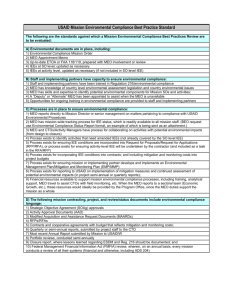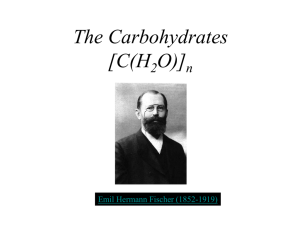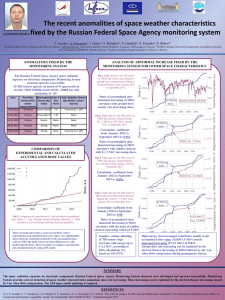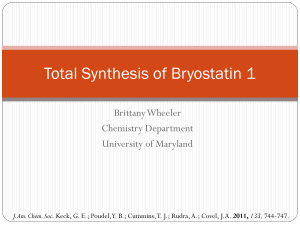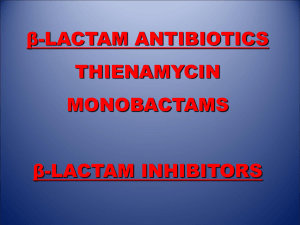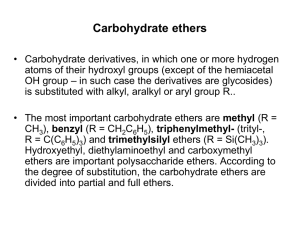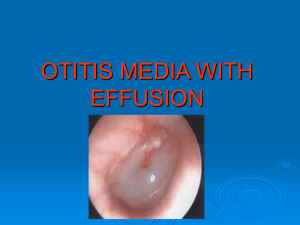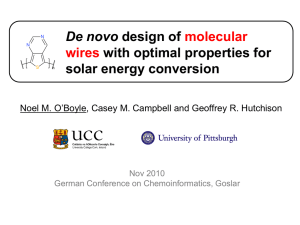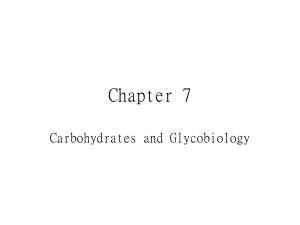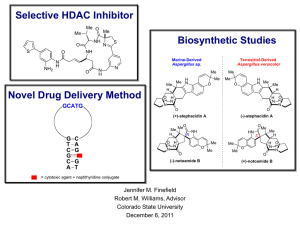ppt
advertisement
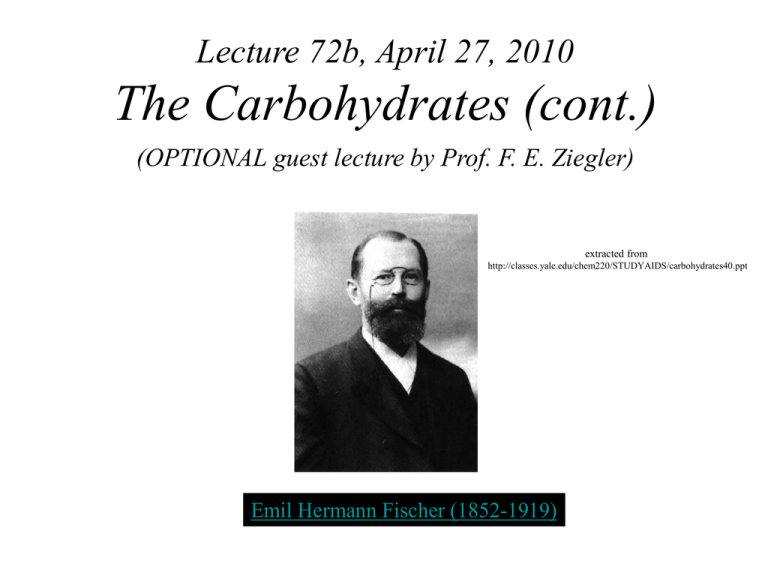
Lecture 72b, April 27, 2010 The Carbohydrates (cont.) (OPTIONAL guest lecture by Prof. F. E. Ziegler) extracted from http://classes.yale.edu/chem220/STUDYAIDS/carbohydrates40.ppt Emil Hermann Fischer (1852-1919) Fischer Projections of Glucose CHO OH 2 HO CHO OH HO 3 4 OH 5 OH CH2OH D-(+)-Glucose = OH form hemiacetals between C5-OH and C1 HOH2C OH rotate C5 about C4 by 120o (Tetrahydro)pyran / (Tetrahydro)furan Fischer Projections of Glucopyranose Anomers left beta HO right alpha C OH HO C OH OH HO OH OH O O CH2OH b-D-(+)-Glucopyranose CH2OH a-D-(+)-Glucopyranose Haworth Projections of Glucopyranose Anomers up (top) beta down (bottom) alpha CH2OH CH2OH OH O O OH OH OH OH OH b-D-(+)-Glucopyranose OH OH a-D-(+)-Glucopyranose Chair Conformations of Glucopyranose Anomers down (bottom) alpha up (top) beta OH OH O O HO HO OH HO HO OH OH OH b-D-(+)-Glucopyranose a-D-(+)-Glucopyranose How an Old Salt Remembers port starboard left right red light green light fewer letters more letters beta alpha up down top bottom Mutarotation of Anomers OH OH O O HO HO OH HO HO OH OH OH b-D-(+)-Glucopyranose a-D-(+)-Glucopyranose Crystallizes above 98oC pure b-anomer mp 150oC [a]D = +18.7o H2 O Crystallizes below 98oC equilibrium mixture [a] = +52.6o ba H2O pure a-anomer mp 146oC [a]D = +112.2o Ring Sizes of Hexoses Hexose Pyranose Form (%a/%b) Furanose Form allose altrose glucose mannose gulose idose galactose talose fructose 92 70 ~100(36.5/63.5) ~100(67/33) 97 75 93(27.5/72.5) 69 67 8 30 <1 <1 3 25 7 31 33 Periodic Acid Cleavage of Carbohydrates as a Diagnostic Tool OH HIO4 2 CH2=O OH OH OH HIO4 CHO HIO4 CH2=O + CH2=O + OH OH HO H2O OH HIO4 OH Formaldehyde (CH2O) arises from a primary alcohols Formic acid (HCO2H) arises from a secondary alcohols HCO2H Periodic Acid Cleavage of Carbohydrates as a Diagnostic Tool OH OH HIO4 2 CH2=O + HCO2H OH CHO OH HIO4 CH2=O + 2 HCO2H • RCH2OH CH2=O • R2CHOH HCO2H • RCH=O HCO2H • R2C=O CO2 OH OH O OH HIO4 CO2H CH2=O + OH HIO4 CH2=O + CO2 Periodic Acid Cleavage of Carbohydrates CHO HCO2H OH HO OH OH CH2OH HCO2H HCO2H HCO2H HCO2H H2CO D-glucose OH H2CO O CO2 OH OH HCO2H HCO2H HCO2H HO CH2OH HO HO OH OH CH2OH D-mannitol H2CO HCO2H HCO2H HCO2H HCO2H H2CO CH2OH D-fructose H2CO Methylation of Pyranoses: Pyranosides OH OH O CH3OH, H+ HO HO HO OH OCH3 CH3O CH3O O HO HO CH3I Ag2O O H3 CH3O OH HO OCH3 (CH3)2SO4 NaOH OCH3 O+ CH3O CH3O O CH3O OCH3 Ring Size of Pyranosides OCH3 CH3O CH3O CO2H O CH3O OCH3 HNO3 CH3O CO2H CO2H HNO3 HNO3 CO2H OCH3 OCH3 CH3O CH3O O CH3O OCH3 CH3O OH CO2H via oxidation of the enol of the ketone Periodic Acid Cleavage of Methyl a-Glucopyranoside OH OH HIO4 O HO HO HCO2H HO OCH3 H3 O+ CHO OH OH D-glyceraldehyde + OHCCHO glyoxal O OHC + CH3OH OHC OCH3 Enzymatic Cleavage of Glucosides HO HO O O HO HO HO HO HO OCH3 H3 O+ OCH3 HO Methyl a-D-glucoside Methyl b-D-glucoside maltase HO emulsin HO O O HO HO HO HO OH HO HO a-D-glucose OH b-D-glucose The Silver Mirror Test HO O Tollens reagent HO HO no reaction HO OCH3 Ag(NH3)2+ OH- Methyl -D-glucoside non-reducing sugar (a glycoside) CO2H HO Tollens reagent O HO HO HO OH Ag(NH3)2+ OH- OH HO OH OH CH2OH + Ago silver mirror D-glucose reducing sugar (an aldose) www.chem-pics.co.uk/download.htm The Silver Mirror Test HO CH2OH OH O HO O HO OH OH Ag(NH3)2 + OH OH OH OH- OH HO OH OH CH2OH b-D-fructofuranose enediol CH2OH D-fructose Ag(NH3)2+ OHCO2H Ago + silver mirror CHO OH Ag(NH3)2 HO + OH- OH OH CH2OH Aldoses and ketoses are reducing sugars OH HO OH OH CH2OH Disaccharides and Polysaccharides a-D-Glucopyranosyl- b -D-fructofuranoside orb-D-Fructofuranosyl-a-D-glucopyranoside OOCR O OH O HO HO acetal HO HO RCOO RCOO RCOO RCOO O O O HO O ketal RCOO OOCR OH HO Sucrose (non-reducing sugar) RCOO Olestra (R=n-CnH2n+1; n=6-8) Sucrose is Formed from Glucose and Fructose This discussion brings to mind a wonderful story told to me by Professor Harry Wasserman (Yale), who during the late 1940's was a graduate student of Professor R. B. Woodward at Harvard. Apparently Woodward had received a notice of a $1,000 prize for the first person to accomplish a chemical synthesis of sucrose. He went into the laboratory and said to his students that all they had to do was connect two molecules of glucose together [...and lose a molecule of water] and they would have themselves $1,000. One student, obviously not overwhelmed by Woodward's stature in the field even at such a young age, replied that if you did it that way, the prize would be $2,000! Sucralose 1,6-Dichloro-1,6-dideoxy-β-D-fructofuranosyl-4-chloro-4-deoxy-α-D-galactopyranoside Cl OH OH galacto O O HO HO HO OH gluco OH O HO O Cl O O OH OH Cl OH OH Sucrose (non-reducing sugar) OH Sucralose (600 times sweeter than sucrose) Bees Do It CHO OH OH HO HO O OH OH HO HO HO CH2OH O or H3O+ O D-glucose [a]D = +52.7o dextrose HO OH invertase OH HO Sucrose [a]D = +66.5o (non-reducing, non-mutarotating sugar) O HO OH OH CH2OH D-fructose [a]D = -92.4o levulose Disaccharides-Cellobiose HO HO O HO HO HO O OHO HO O O HO HO OH HO b-acetal linkage n partial hydrolysis H3O+ HO HO HO emulsin,b-glucosidase (termites, ruminants) 4-O-attachment HO O O OHO HO Cellulose (polysaccharide) OH HO Cellobiose (disaccharide) 4-O-(b-D-glucopyranosyl)-D-glucopyranose Cellobiose-Structure Proof HO HO HO HO O OHO HO Br2/H2O O OH HO HO O HO HO OH OHO HO CO2H HO HO Cellobiose permethylation •hydrolysis ----> only D-glucose •emulsin ----> b-glucoside MeO O MeO MeO MeO OMe O MeO MeO MeO CO2H •positive Tollens test ----> reducing sugar H3O+ •shows mutarotation CHO CO2H OMe OMe MeO MeO OH OMe CH2OMe tetramethoxycarboxylic acid OMe OH CH2OMe tetramethoxy aldehyde HO HO O HO HO OHO HO O OH Cellobiose-Structure Proof HO MeO MeO MeO O MeO OMe O MeO MeO CO2H MeO CO2H OMe MeO CO2H CHO CO2H OMe dimethyl L-tartaric acid MeO OMe OH CH2OMe hot HNO3 OMe MeO hot HNO3 tetramethoxy aldehyde OH OMe CH2OMe tetramethoxycarboxylic acid CO2H OMe CO2H OMe MeO OMe CH2OMe CO2H trimethyl xylaric acid dimethyl Dglyceric acid Disaccharides: Maltose Starches: poly-a-D-glucosides Malt (barley) maltase HO O HO HO HO HO O O OH HO HO •hydrolysis ----> only D-glucose •maltase ----> a-glucoside •positive Tollens test ----> reducing sugar •shows mutarotation •differs from cellobiose at the glycosidic anomeric center Disaccharides: Lactose 4-O-(b-D-galactopyranosyl)-D-glucose ~5% of human and cow milk HO HO HO O OHO HO HO O OH HO •hydrolysis ----> D-glucose and D-galactose •b-galactosidase (lactase) ----> b-galactoside •lactose intolerance •positive Tollens test ----> reducing sugar •shows mutarotation Disaccharides: Amygdalin Laetrile (laevorotatory mandelonitrile), “vitamin 17” 1,6-b-linkage HO O HO HO O HO O HO HO CN O HO H b-linkage Ph cyanohydrin of benzaldehyde 1836 - Isolated from bitter almonds by Wohler. Demonstrated that emulsin produces glucose, benzaldehyde and prussic acid (HCN) Touted in some circles as a treatment for cancer. Cellulose: Chain Length HO HO O HO HO HO O OHO HO O O HO HO OH HO n permethylation MeO MeO O MeO MeO MeO O O MeO MeO O O MeO MeO OMe MeO n H3O+ 2,3,4,6-tetra-Omethyl D-glucose (terminal) MeO MeO O O HO MeO MeO MeO MeO 0.6% OH MeO 99.4% OH 2,3,6-tri-Omethyl D-glucose (chain) 100-200 units Starches: Plant Polysaccharides HO O HO HO HO HO O O HO HO HO O O HO n HO Amylose : • ~20% water soluble starch; poly 4-O-(a-D-glucoside) • forms helical structure; blue complex with iodine OH Starches: Plant Polysaccharides Amylopectin: • ~80% water insoluble starch branched poly-4-O-(a-D-glucoside) • permethylation/hydrolysis 90% 2,3,6-tri-O-methyl-D-glucose ~5% 2,3-di-O-methyl-D-glucose ~5% 2,3,4,6-tetra-O-methyl-D-glucose MeO HO O HO MeO HO MeO MeO chain MeO O OH MeO OH junction Average 20 glucose units /chain O MeO MeO MeO terminus OH And Finally, a True Story In March of 1986 I was in California visiting several universities. While at Stanford University, I stopped at the the health center to have a swollen foot examined. The young resident was very attentive. To assess his qualifications, I asked him where he had attended college. “M.I.T.,” he responded. “So you must have had Professor Kemp for organic chemistry,” I countered. “Yes, I did,” he said. Then I asked, “What D-aldohexose forms the same osazone as glucose?” Like Diogenes the Cynic in search of an honest man (person), I have posed this question to many a practitioner of the medical and dental professions. Neither Diogenes nor I have fulfilled our quests. However, the responses to my query were often amusing. Response: My thought: “I really enjoyed organic chemistry!” Really? “Organic, don’t remind me!” An honest man? “I know the mechanism of the aldol condensation.” Wrong chapter! “I know what a Grignard reagent is.” Wrong test! “Wait! Give me some time.” “It’s only an hour exam.” The Moral of the Story Somewhere,…sometime…someone might ask you this question. What D-aldohexose forms the same osazone as D-glucose? Your answer will be... D-Mannose! The End
